The Best Pizza Sauce
This post may contain affiliate links. For more information, please see our disclosure policy.
Get ready for an authentic pizzeria-style sauce recipe that is both easy and no cook. This sauce is the real deal, made from a blend of tomato sauce, extra virgin olive oil, and dried spices, and fresh herbs. It’s the secret behind those legendary New York slices, and now you can bring that iconic taste to your own kitchen!
So roll up your sleeves, grab your favorite pizza toppings, and get ready to savor every mouthwatering bite of this genuinely amazing pizza sauce!
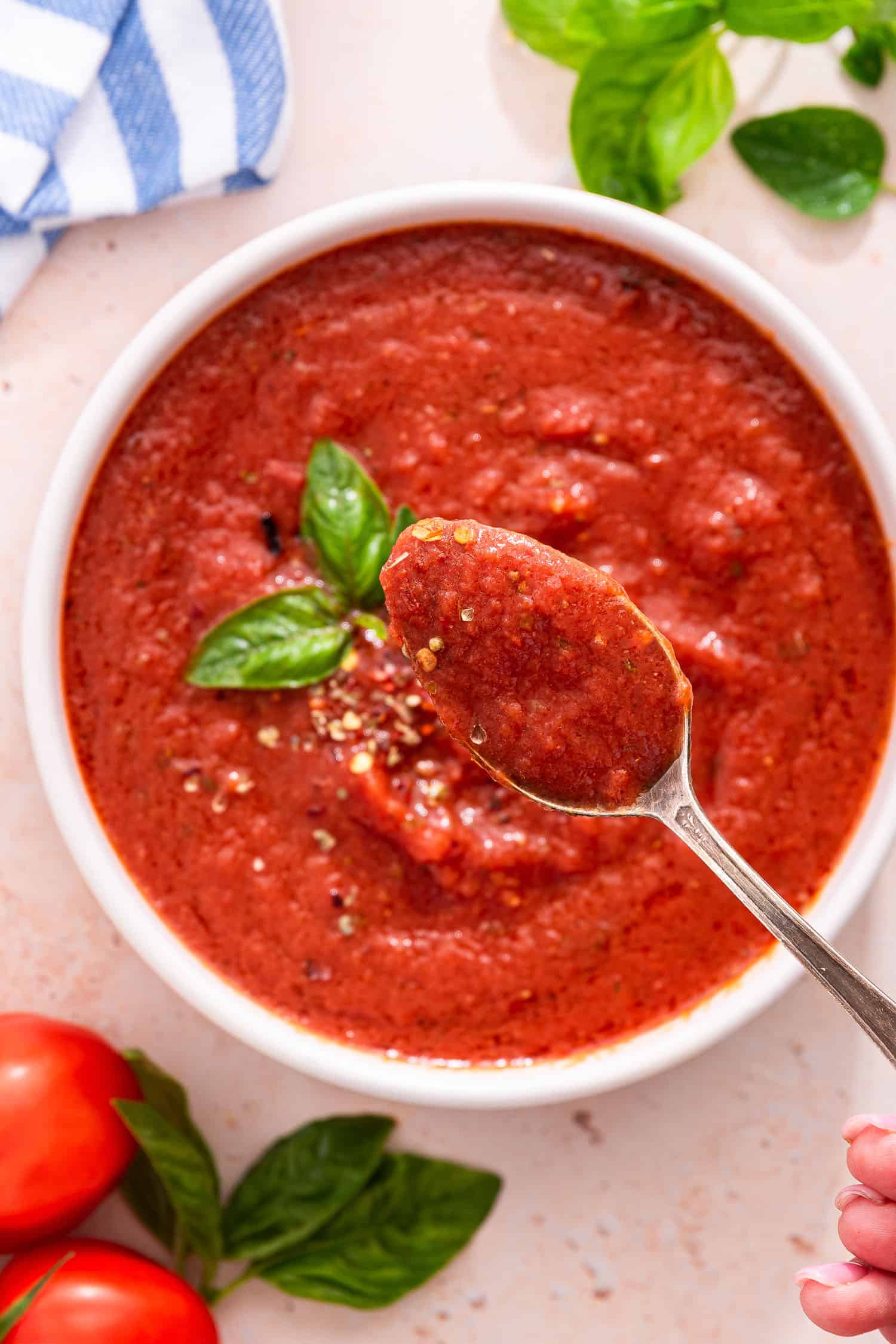
Since writing my first post on making NY style pizza dough, I’ve gotten a few requests for a good pizza sauce recipe. The pizza dough is only part of the making of a good pizza (although an important part if you ask me)- finding a good sauce recipe and a favorite cheese combination is definitely the other part of the battle for good pizza. If you need to calculate how much dough you need try our pizza calculator! And if you have leftover sauce and want to use it, try my stuffed peppers – they will NOT disappoint!
Jump to:
- Why You’l Love this Recipe
- What Makes a Good Pizza Sauce?
- Ingredients
- Method: It’s So Easy!
- Back of the Spoon Test: Getting the Best Consistency
- To Cook or Not to Cook?
- Types of Canned Tomato Products
- How Much Pizza Sauce Do I Need?
- Tips and Tricks
- Storage and Make Ahead
- Frequently Asked Questions
- 📖 Recipe
Why You’l Love this Recipe
So, why make this pizza sauce? And what makes it the best?
- It’s incredibly easy to make – you are basically just measuring and mixing (and sometimes I just “eyeball” it!)
- The recipe comes from a pizzeria owner in NYC who knows good food!
- It’s got the perfect balance of flavors from the tomatoes, herbs, and spices.
- It’s very easy to customize to your liking.
- It’s easy to make ahead and keep on hand!
What Makes a Good Pizza Sauce?
Without question, the quest for a good pizza sauce recipe largely depends on using high quality tomato sauce products, much like I said when I wrote my creamy tomato soup recipe.
Choosing a tomato brand will depend on your tastes and what products are available in your area. A few of my favorites brands include Red Pack (which seems hard to find), Cento, Muir Glen, and of course, San Marzano. I also like Tutto Rosso and Nina brands. Bianco Di Napoli and Jersey Fresh are also very very good.
The pizza sauce should have a well-balanced combination of sweetness, acidity, and savory notes. The sweetness comes from the natural sugars in the tomatoes, while the acidity adds brightness and helps cut through the richness of the cheese and other toppings.
Ingredients

Method: It’s So Easy!
After mixing the sauce ingredients, it does help to let the sauce sit for a while in the refrigerator to let the flavors marry. I have skipped this step in a pinch, but plan to do so if you can.
The recipe is quite simple if you have all the ingredients – just mix, let sit, and use.
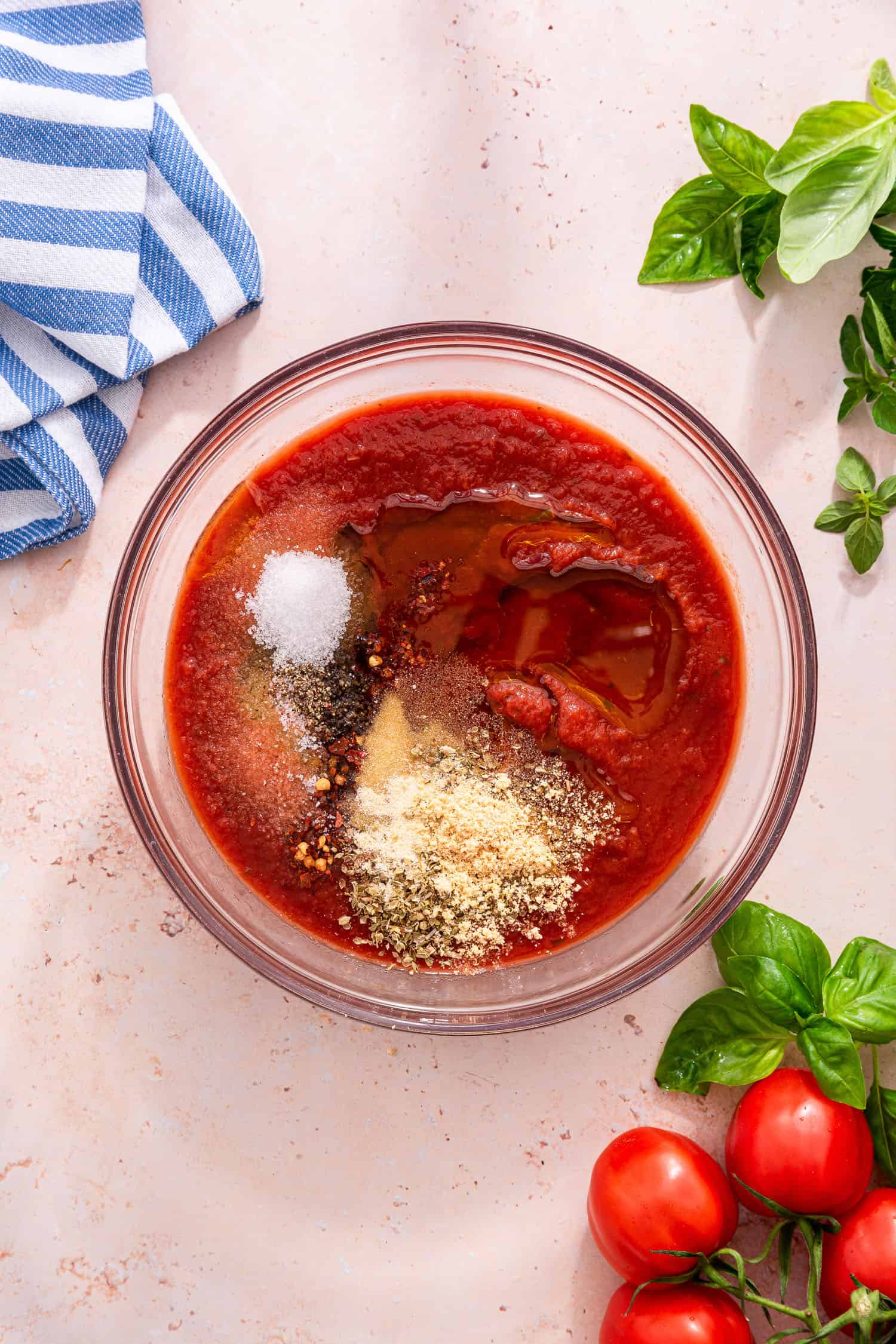
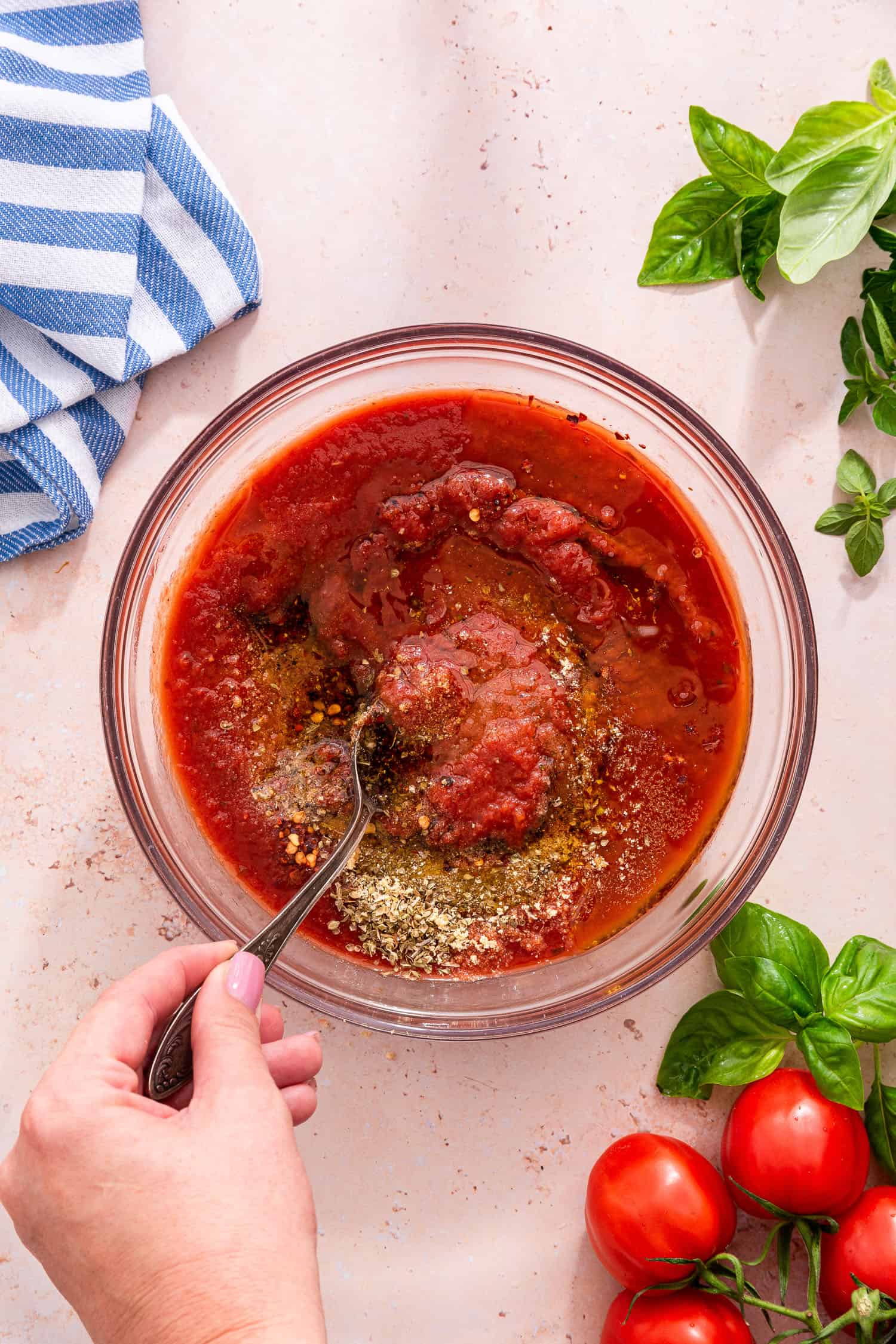
Back of the Spoon Test: Getting the Best Consistency
So how do you get the perfect consistency to your pizza sauce? If you’re like me and you sometimes like to use tomato puree, which can be too thick (but delicious), you’ll need to water it down a bit.
But how much?
The “back of the spoon” method is a simple technique to test the consistency of a sauce, including pizza sauce. Here’s how you can use it:
- Prepare your pizza sauce according to the directions.
- Take a spoonful of the sauce and let it sit on the back of a spoon. Make sure to use a spoon with a convex, rounded back rather than a flat one.
- Observe how the sauce behaves on the back of the spoon. Pay attention to its thickness and how it spreads or flows.
- If the sauce is too thin and runs off the spoon immediately without leaving a coating, it may be too watery. In this case, you might want to thicken it by cooking it or adding a small amount of tomato paste.
- If the sauce is too thick and doesn’t move or spread easily, it might be too dense. You can adjust it by adding a little water (a small amount at a time and then retesting) to achieve a smoother consistency.
- Ideally, the sauce should have a balanced consistency, neither too thin nor too thick. It should gently coat the back of the spoon and slowly drip or flow off it.
By using the back of the spoon method, you can visually assess the sauce’s thickness and determine if any adjustments are needed. Keep in mind that personal preferences can vary, so feel free to make further modifications based on your taste and the desired texture for your pizza sauce.
To Cook or Not to Cook?
One subject of controversy is to whether to cook pizza sauce before using it.
I do not precook my sauce and from what I have read, most NY style pizza makers do not pre-cook their sauce.
From what I understand, the tomato puree (and tomato sauce) is already precooked, so that helps to impart the deeper flavor that you get when you cook pasta sauce – possibly another reason that I like to use tomato puree.
Types of Canned Tomato Products
I find that tomato puree and tomato sauce have a cooked flavor, which I prefer for NY style pizzas. If I’m making Neapolitan pizza, then I use fresh whole tomatoes and smash them (and that particular type of sauce does not call for many ingredients).
Here’s a table comparing tomato sauce, tomato puree, tomato paste, crushed tomatoes, diced tomatoes, and whole peeled tomatoes:
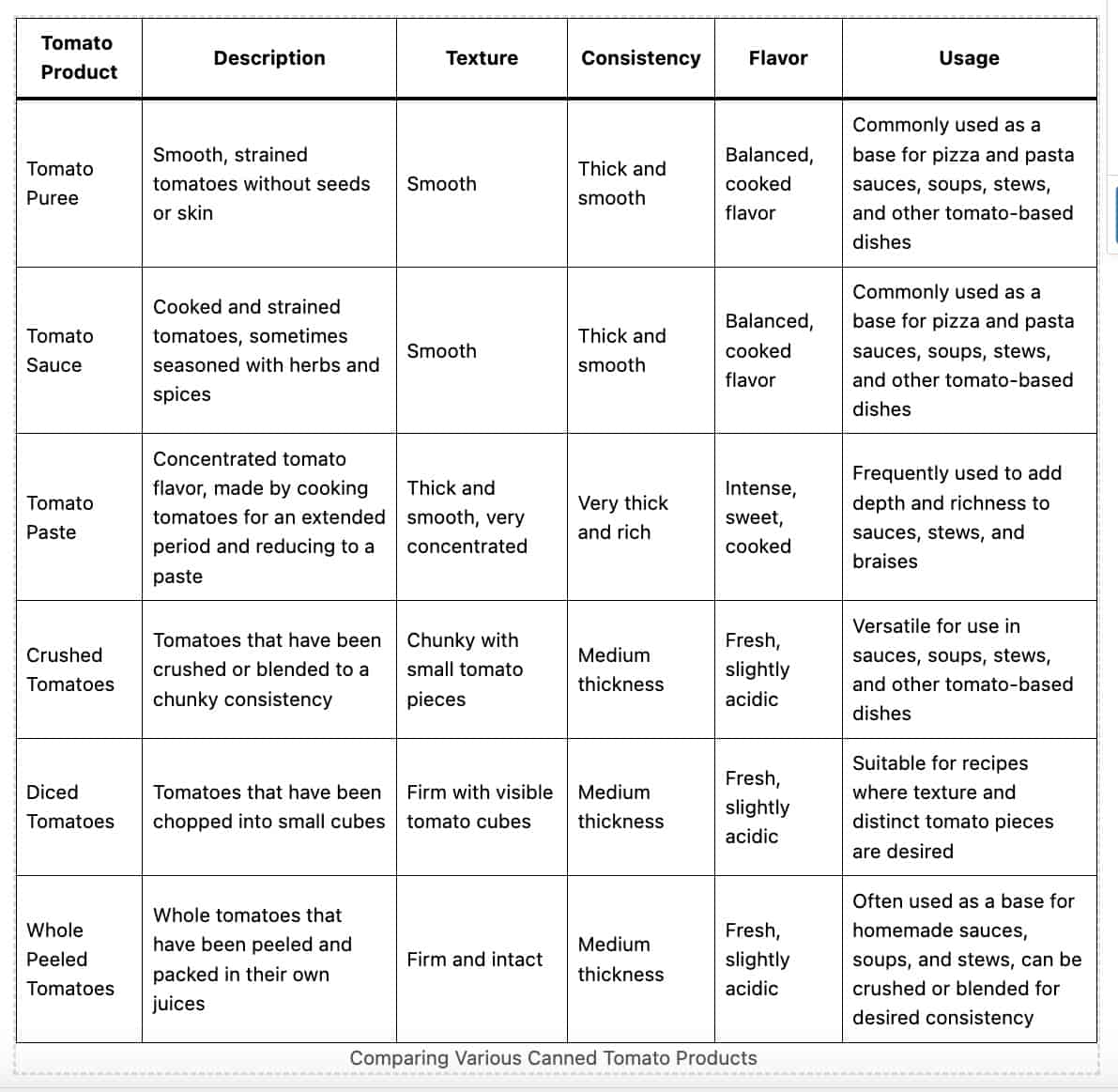
How Much Pizza Sauce Do I Need?
This recipe makes a little more than 4 cups and you can easily cut the recipe in half using the 0.5x option in the recipe card below.
The amount of pizza sauce you use per pizza depends on personal preference and the thickness of the sauce. However, as a general guideline, a range of sauce amounts typically used is as follows:
- 12-inch pizza: 1/2 to 3/4 cup (approximately 118 mL to 177 mL) of pizza sauce.
- 14-inch pizza: 3/4 to 1 cup (approximately 177 mL to 237 mL) of pizza sauce.
- 16-inch pizza: 1 to 1 1/4 cups (approximately 237 mL to 296 mL) of pizza sauce.
Note that it’s always a good idea to start with a moderate amount and adjust to your liking as needed. Too much sauce can make your pizza soggy and hard to transfer to your pizza stone or steel (if you use one).
Tips and Tricks
- Choose a brand of tomatoes that you know and love. It might take a while to try different ones but the tomatoes really make the sauce.
- High quality olive oil will also make your sauce stand out so splurge a little here and try good different brands.
- Add salt slowly and test for saltiness. Customize to your liking.
- Although this recipe takes only 5 or 10 minutes to make, if you make it ahead or the day before, you’ll give the tomato sauce time to to marinate in the flavors and for the flavors to marry and so it’ll be even better.
Storage and Make Ahead
- Pizza sauce can be made ahead of time and stored for convenience.
- Store it in an airtight container.
- Homemade pizza sauce can be refrigerated for 5-7 days.
- To freeze pizza sauce, pour it into a freezer-safe container, leaving some headspace, and store it for up to 3-4 months.
- Thaw frozen pizza sauce by transferring it to the refrigerator overnight or using quick thawing methods like the microwave or warm water.
- Reheat pizza sauce gently over low to medium heat, stirring occasionally, without boiling it.
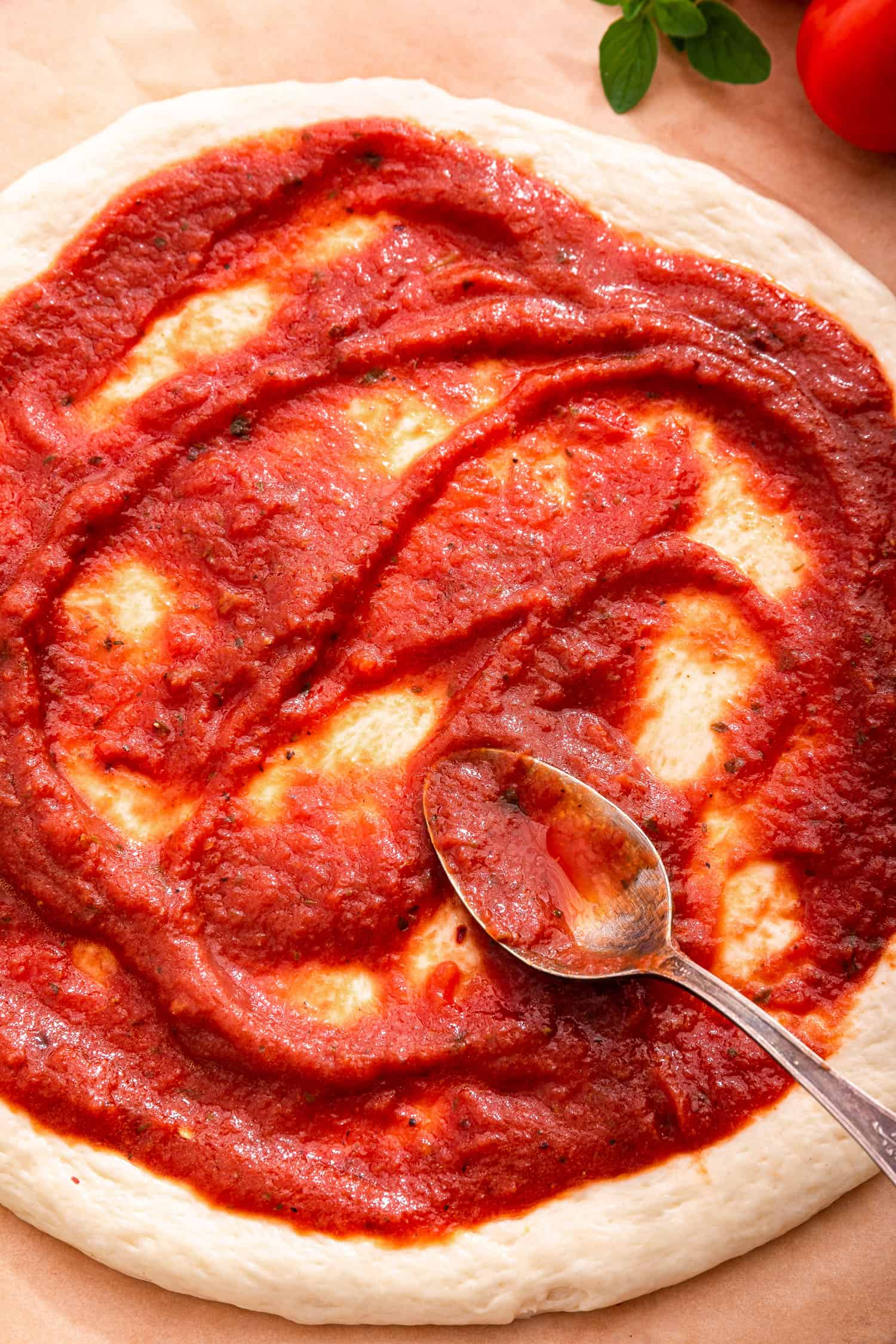
Frequently Asked Questions
Yes! To get smooth tomato sauce from fresh tomatoes, you can follow these steps:
Choose ripe tomatoes: Select ripe tomatoes that are vibrant in color and have a slight give when gently pressed. Ripe tomatoes tend to have more flavor and are easier to work with when making sauce.
Blanch and peel the tomatoes: Bring a pot of water to a boil and prepare an ice bath by filling a bowl with ice and water. Score a small “X” on the bottom of each tomato.
Carefully place the tomatoes in the boiling water for about 30 seconds to 1 minute until the skins start to loosen. Using a slotted spoon, transfer the tomatoes to the ice bath to cool quickly. Once cooled, remove the skins by gently peeling them off.
Remove the seeds (optional): Cut the peeled tomatoes in half horizontally and gently squeeze or scoop out the seeds and any excess juice. This step is optional but can help prevent the sauce from becoming too watery.
Blend or process the tomatoes: Place the peeled and seeded tomatoes in a blender or food processor. Pulse or blend until the tomatoes reach a smooth consistency.
Be careful not to over-process, as it may turn the sauce too thin.
Strain the sauce (optional): If you desire an even smoother sauce, you can strain it to remove any remaining pulp or seeds. Place a fine-mesh sieve or cheesecloth-lined colander over a bowl and pour the blended sauce into it.
Allow the sauce to strain for a few minutes, gently pressing with a spoon to extract as much liquid as possible.
Season the sauce: Transfer the smooth tomato sauce to a bowl and season it as directed in the recipe. Taste and adjust the seasoning to your preference.
Remember, the quality and ripeness of the tomatoes will greatly impact the flavor and texture of the sauce, so choose the best tomatoes available for the best results.
For a no-cook pizza sauce, you have several options for tomato products that work well:
Tomato Sauce: Tomato sauce is an excellent option. It has a smooth consistency and works well as a base for the sauce. Choose a good-quality tomato sauce without any added flavors or seasonings.
Canned Tomato Puree: Tomato puree is a thick and smooth tomato product that works perfectly for no-cook pizza sauce. It provides a rich and velvety texture to the sauce. Ensure you select pure tomato puree without any added ingredients.
Canned Crushed Tomatoes: Canned crushed tomatoes are a popular choice for no-cook pizza sauce. They have a slightly chunky texture and a good balance of flavors. Look for high-quality crushed tomatoes with no added ingredients. You may want to add some tomato paste to impart a cooked flavor.
Canned Whole Tomatoes: Of course, you can also use canned whole tomatoes and blend them. These are typically very good but also require a little more work to get the consistency right for this pizza sauce recipe.
Yes, you can make this ahead. Store the sauce in a airtight container in the refrigerator for 5 to 7 days or in the freezer for 3 to 4 months.
📖 Recipe
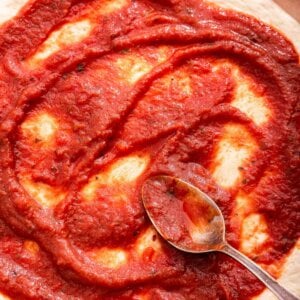
The Best Pizza Sauce
Ingredients
- 28 oz (793.79 g) tomato puree or tomato sauce (I now prefer sauce; you can also use diced tomato, whole tomatoes that you puree yourself, etc)
- 1/2 cup (118.29 g) water (**only if using store bought puree**)
- 1/4 cup (54 g) olive oil
- fresh basil large handful (I only use this in summer when in season, you can also use basil paste or frozen cubes) do not use dried basil.
- 1-2 teaspoons (4 g) sugar (optional – taste your tomatoes first as they all differ in sweetness and then, if needed, add a little at a time)
- 2 teaspoons (12 g) salt
- 1 teaspoon (2 g) dried oregano
- 1.5 teaspoon (4.5 g) garlic powder
- 1 teaspoon (2 g) onion powder
- pinch of red pepper flakes (optional)
- 1/2 teaspoon (1 g) ground black pepper (optional)
Instructions
To Mix Sauce
- Combine all ingredients except water in a bowl and mix well
- If you used puree, slowly add water, using more or less if necessary until you reach desired consistency.
- The sauce should be thick enough to coat the back of a wooden spoon but thin enough to spread easily on the pizza.
- Keep in mind that the sauce thickens a bit in the oven when baked on pizza, so if it is too thick to begin with you will end up with paste.
Optional: Back of the Spoon Test for Consistency
- Take a spoonful of the sauce and let it sit on the back of a spoon. Make sure to use a spoon with a convex, rounded back rather than a flat one.
- If the sauce is too thin and runs off the spoon immediately without leaving a coating, it may be too watery. In this case, you might want to thicken it by adding a small amount of tomato paste (or cook it over low heat, slowly, to thicken it).
- If the sauce is too thick and doesn't move or spread easily, it might be too dense. You can adjust it by slowly adding a little water (1 tablespoon at a time) to achieve a smoother consistency.
- Ideally, the sauce should have a balanced consistency, neither too thin nor too thick. It should gently coat the back of the spoon and slowly drip or flow off it.
Notes
- Pizza sauce can be made ahead of time and stored for convenience.
- Store it in an airtight container.
- Homemade pizza sauce can be refrigerated for 5-7 days.
- To freeze pizza sauce, pour it into a freezer-safe container, leaving some headspace, and store it for 3-4 months.
- Thaw frozen pizza sauce in the refrigerator overnight or use quick thawing methods like the microwave or warm water.
- Reheat pizza sauce gently over low to medium heat, stirring occasionally, without boiling it.

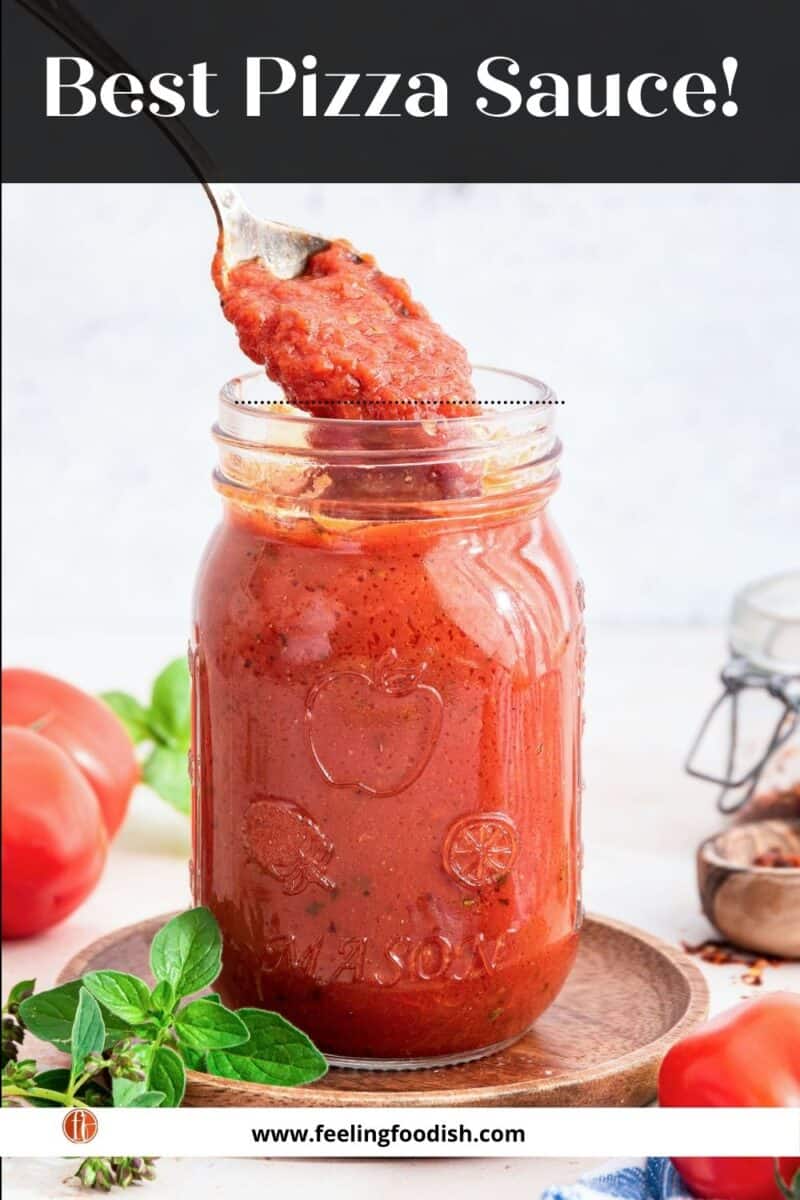
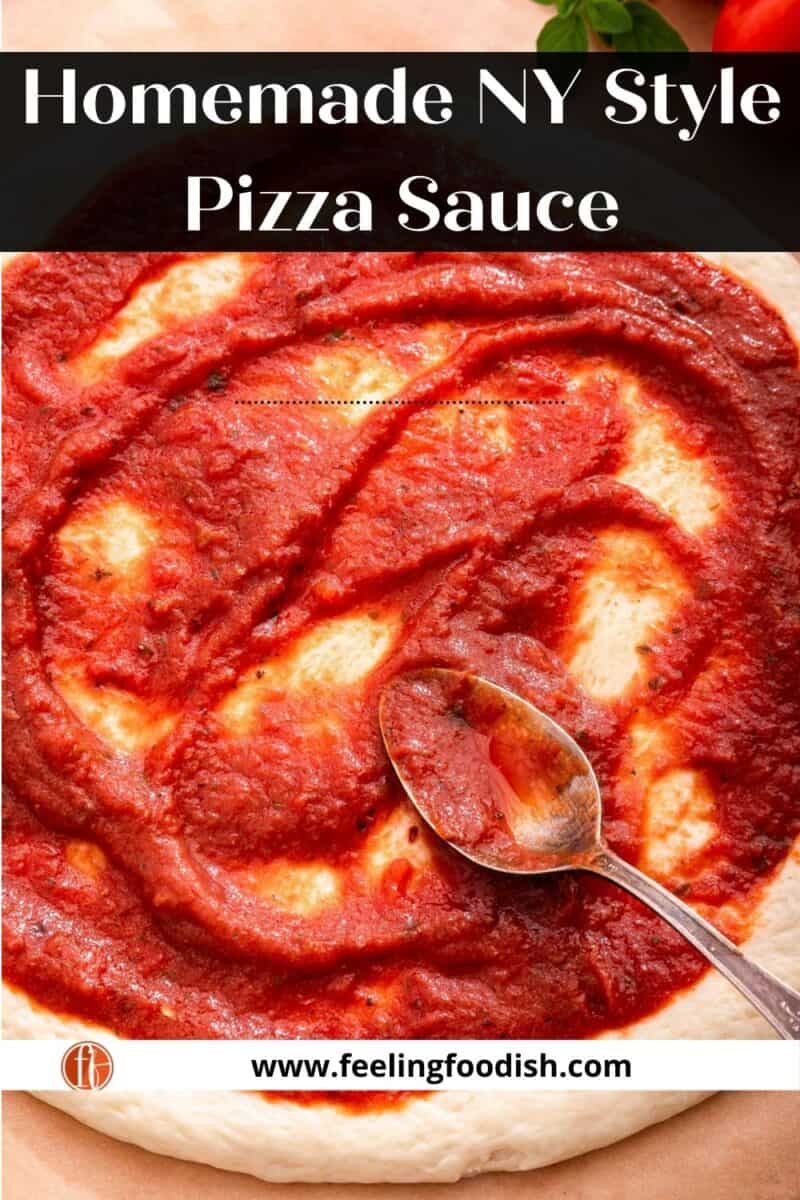
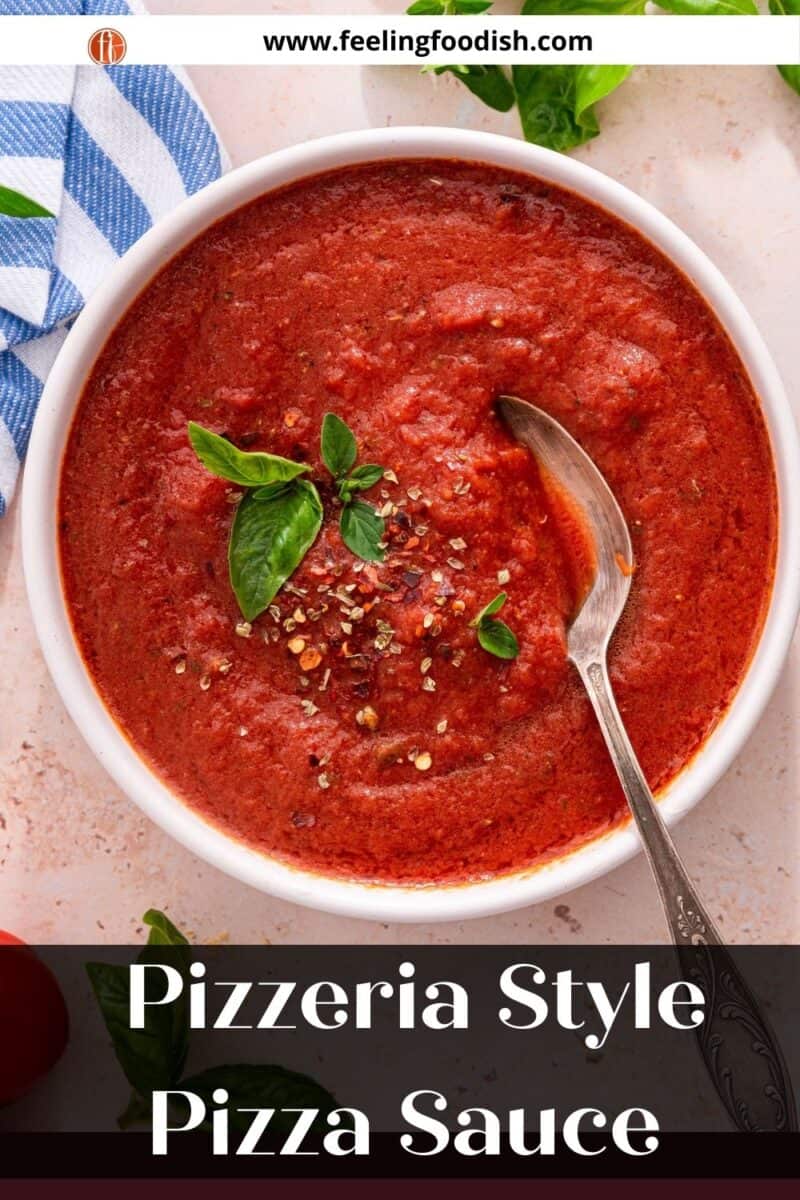
The best ever! And just happens to be fast too! No need to labor for hours when this is ever better than the all day recipe my Mom taught me. (Sorry, Mom) 🙂
Aweee, that’s a huge compliment!
Hi
I followed your recipe but had to add 7 times the amount of ingredients that you listed as I was using 2 large cans, one 7/11 and 1 full Red pizza sauce for a total of 0ver 192 oz. Got a lot of sauce. Can’t wait to try it on a pizza.
John
Hi
If you remember, I wrote to you about your recipe for NY style pizza dough which I follow. I am now going to try in part your sauce. It’s seems no one from NY will give out their sauce recipe. I already have been using 7/11 28oz can of ground tomatoes but now I am going to add a 28oz can of full red fully prepared pizza sauce and Badia oregano. To that I will add fresh basil. Not sure and about sugar and salt and garlic salt or powder. What do you think they use in the NY pizza shops. Is that where you can up with your recipe? I am trying to get it right because as you can see, I am mixing up a lot of tomatoes. Mixing the two can is because one is pretty thick by itself so the second can should make it just right. Thanks for your thoughts.
John